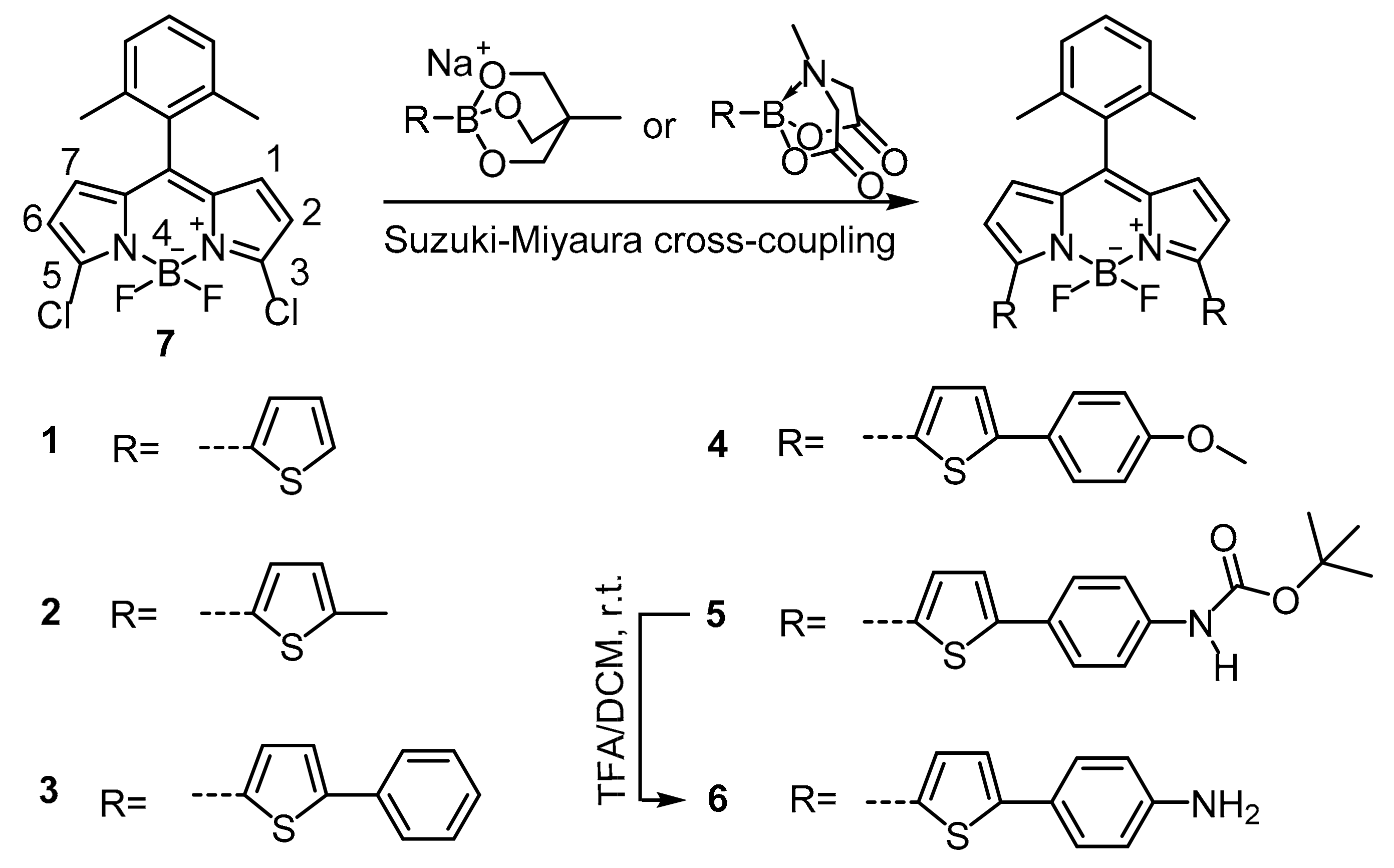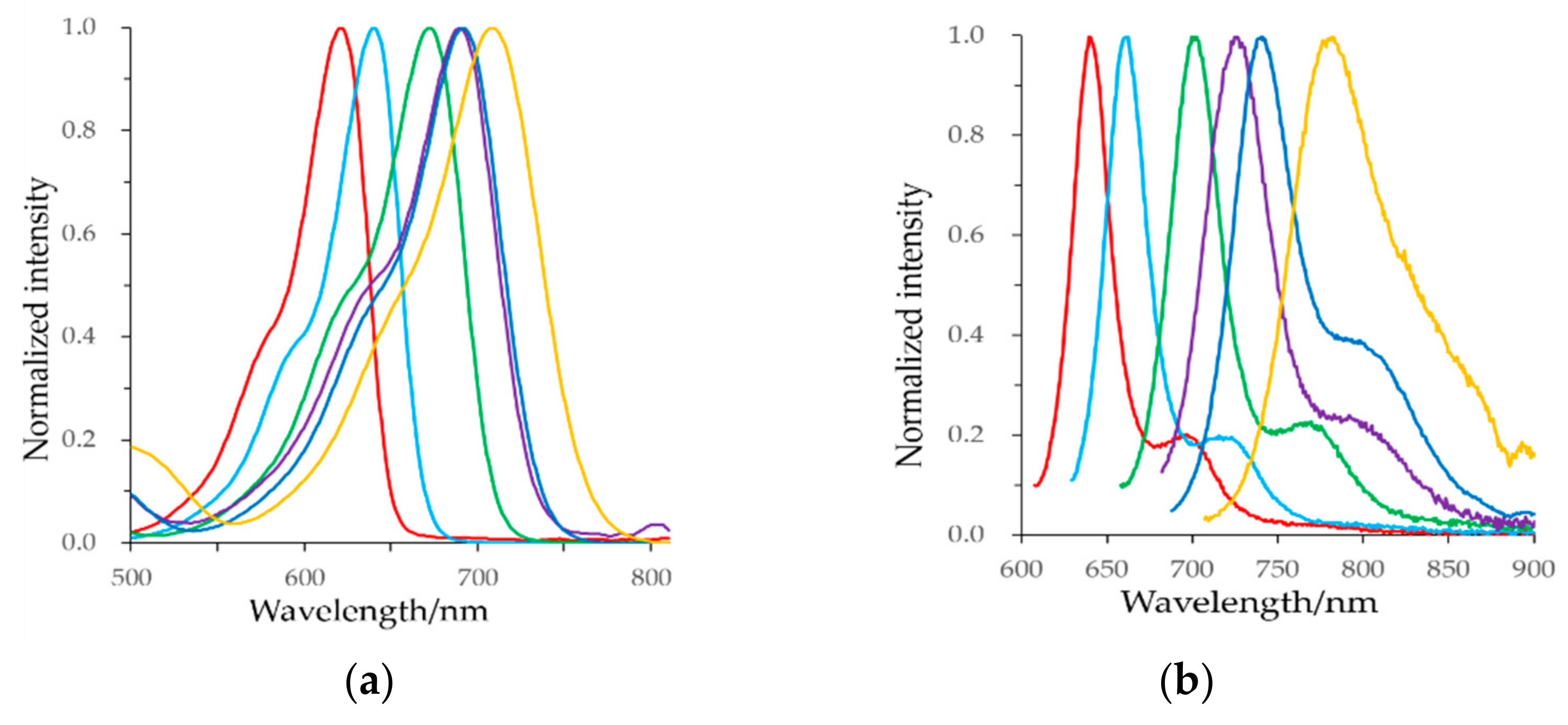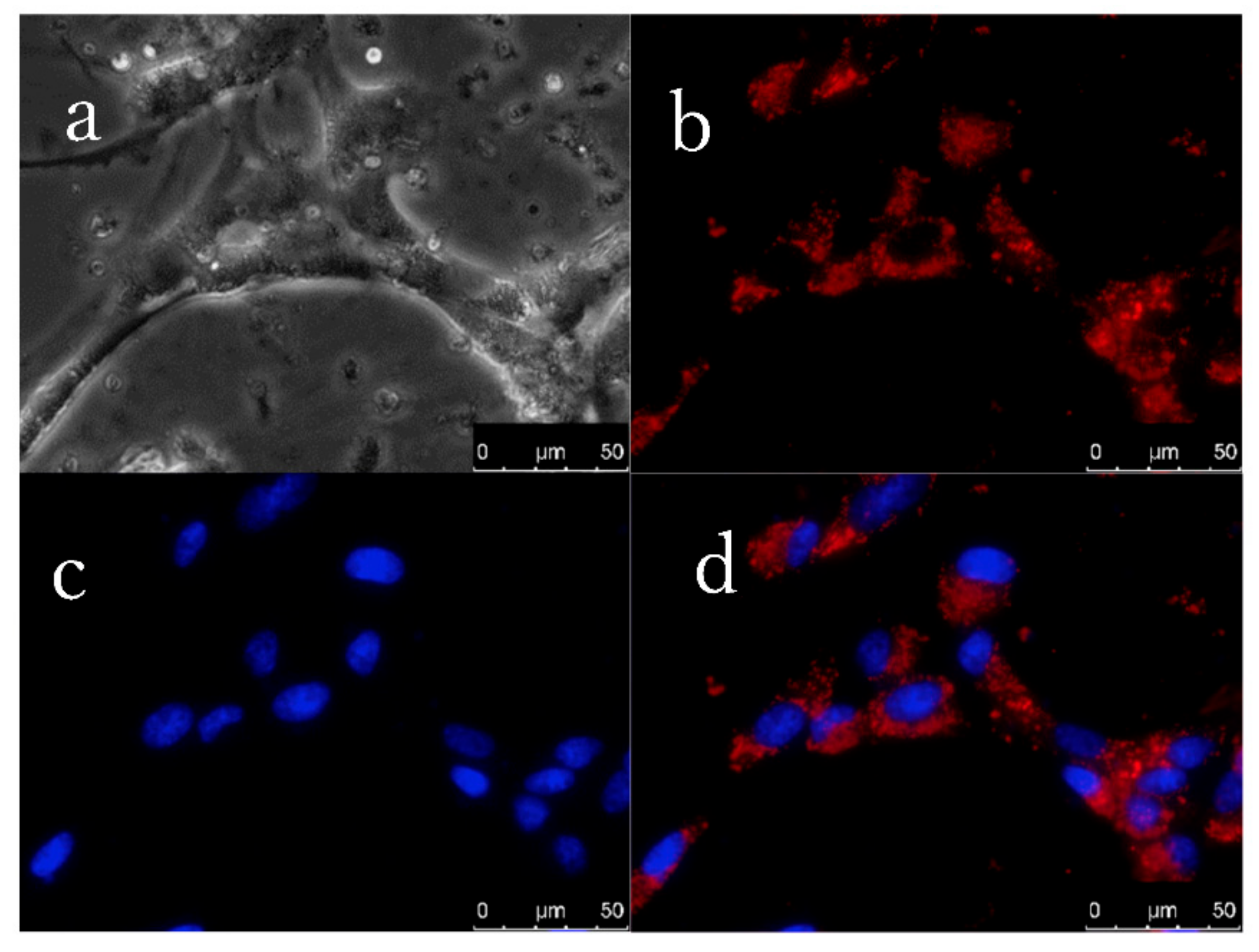A Straightforward Substitution Strategy to Tune BODIPY Dyes Spanning the Near-Infrared Region via Suzuki–Miyaura Cross-Coupling
Abstract
1. Introduction
2. Materials and Methods
2.1. General Experimental
2.2. Synthesis of BODIPY Dyes 1–6
2.2.1. General Procedure: Synthesis of Dyes 1–4
Synthesis of 8-(2,6-Dimethylphenyl)-3,5-di(2-thienyl)-BODIPY (1)
Synthesis of 8-(2,6-Dimethylphenyl)-3,5-di(5-methyl-2-thienyl)-BODIPY (2)
Synthesis of 8-(2,6-Dimethylphenyl)-3,5-di[(5-phenyl(2-thienyl)]-BODIPY (3)
Synthesis of 8-(2,6-Dimethylphenyl)-3,5-di[(5-phenyl(2-thienyl)]-BODIPY (4)
2.2.2. Synthesis of 8-(2,6-Dimethylphenyl)-3,5-di[5-(4-BOC-aminophenyl)-2-thienyl)]-BODIPY (5)
2.2.3. Synthesis of 8-(2,6-Dimethylphenyl)-3,5-di[5-(4-aminophenyl)-2-thienyl)]-BODIPY (6)
2.3. Collection and Culture of Bovine Cumulus Cells
2.4. Cellular Staining Study of Dye 1
3. Results and Discussion
3.1. Synthesis of Dyes 1–6
3.2. Spectroscopic and Photophysical Properties of Dyes 1–6
3.3. Cellular Imaging of Dye 1
4. Conclusions
Supplementary Materials
Author Contributions
Funding
Acknowledgments
Conflicts of Interest
References
- Escobedo, J.O.; Rusin, O.; Lim, S.; Strongin, R.M. Nir dyes for bioimaging applications. Curr. Opin. Chem. Biol. 2010, 14, 64–70. [Google Scholar] [CrossRef] [PubMed]
- Peng, X.; Song, F.; Lu, E.; Wang, Y.; Zhou, W.; Fan, J.; Gao, Y. Heptamethine cyanine dyes with a large stokes shift and strong fluorescence: A paradigm for excited-state intramolecular charge transfer. J. Am. Chem. Soc. 2005, 127, 4170–4171. [Google Scholar] [CrossRef] [PubMed]
- Pansare, V.J.; Hejazi, S.; Faenza, W.J.; Prud’homme, R.K. Review of long-wavelength optical and NIR imaging materials: Contrast agents, fluorophores, and multifunctional nano carriers. Chem. Mater. 2012, 24, 812–827. [Google Scholar] [CrossRef] [PubMed]
- Boens, N.; Leen, V.; Dehaen, W. Fluorescent indicators based on BODIPY. Chem. Soc. Rev. 2012, 41, 1130–1172. [Google Scholar] [CrossRef] [PubMed]
- Ulrich, G.; Ziessel, R.; Harriman, A. The chemistry of fluorescent bodipy dyes: Versatility unsurpassed. Angew. Chem. 2008, 47, 1184–1201. [Google Scholar] [CrossRef] [PubMed]
- Descalzo, A.B.; Xu, H.-J.; Xue, Z.-L.; Hoffmann, K.; Shen, Z.; Weller, M.G.; You, X.-Z.; Rurack, K. Phenanthrene-fused boron− dipyrromethenes as bright long-wavelength fluorophores. Org. Lett. 2008, 10, 1581–1584. [Google Scholar] [CrossRef] [PubMed]
- Jiao, L.; Yu, C.; Liu, M.; Wu, Y.; Cong, K.; Meng, T.; Wang, Y.; Hao, E. Synthesis and functionalization of asymmetrical benzo-fused bodipy dyes. J. Org. Chem. 2010, 75, 6035–6038. [Google Scholar] [CrossRef] [PubMed]
- Loudet, A.; Burgess, K. Bodipy dyes and their derivatives: Syntheses and spectroscopic properties. Chem. Rev. 2007, 107, 4891–4932. [Google Scholar] [CrossRef] [PubMed]
- Hayashi, Y.; Obata, N.; Tamaru, M.; Yamaguchi, S.; Matsuo, Y.; Saeki, A.; Seki, S.; Kureishi, Y.; Saito, S.; Yamaguchi, S.; et al. Facile synthesis of biphenyl-fused bodipy and its property. Org. Lett. 2012, 14, 866–869. [Google Scholar] [CrossRef] [PubMed]
- Zhao, W.; Carreira, E.M. Conformationally restricted aza-bodipy: Highly fluorescent, stable near-infrared absorbing dyes. Chemistry 2006, 12, 7254–7263. [Google Scholar] [CrossRef] [PubMed]
- McDonnell, S.O.; O’Shea, D.F. Near-infrared sensing properties of dimethlyamino-substituted BF2-azadipyrromethenes. Org. Lett. 2006, 8, 3493–3496. [Google Scholar] [CrossRef] [PubMed]
- Xuan, S.; Zhao, N.; Ke, X.; Zhou, Z.; Fronczek, F.R.; Kadish, K.M.; Smith, K.M.; Vicente, M.G. Synthesis and spectroscopic investigation of a series of push-pull boron dipyrromethenes (bodipys). J. Org. Chem. 2017, 82, 2545–2557. [Google Scholar] [CrossRef] [PubMed]
- Yu, Y.H.; Descalzo, A.B.; Shen, Z.; Röhr, H.; Liu, Q.; Wang, Y.W.; Spieles, M.; Li, Y.Z.; Rurack, K.; You, X.Z. Mono-and di (dimethylamino) styryl-substituted borondipyrromethene and borondiindomethene dyes with intense near-infrared fluorescence. Chem.-Asian J. 2006, 1, 176–187. [Google Scholar] [CrossRef] [PubMed]
- Zhang, X.; Yu, H.; Xiao, Y. Replacing phenyl ring with thiophene: An approach to longer wavelength aza-dipyrromethene boron difluoride (aza-bodipy) dyes. J. Org. Chem. 2012, 77, 669–673. [Google Scholar] [CrossRef] [PubMed]
- Poirel, A.; De Nicola, A.; Ziessel, R. Oligothienyl-bodipys: Red and near-infrared emitters. Org. Lett. 2012, 14, 5696–5699. [Google Scholar] [CrossRef] [PubMed]
- Ni, Y.; Wu, J. Far-red and near infrared bodipy dyes: Synthesis and applications for fluorescent pH probes and bio-imaging. Org. Biomol. Chem. 2014, 12, 3774–3791. [Google Scholar] [CrossRef] [PubMed]
- Son, S.H.; Abe, Y.; Yuasa, M.; Yamagishi, Y.; Sakai, N.; Ayabe, T.; Yamada, K. A systematic analysis of aromatic heterocyclic rings in solvatochromic fluorophores. Chem. Lett. 2011, 40, 378–380. [Google Scholar] [CrossRef]
- Diwu, Z.; Lu, Y.; Zhang, C.; Klaubert, D.H.; Haugland, R.P. Fluorescent molecular probes ii. The synthesis, spectral properties and use of fluorescent solvatochromic dapoxyl dyes. Photochem. Photobiol. 1997, 66, 424–431. [Google Scholar] [CrossRef]
- Weber, G.; Farris, F.J. Synthesis and spectral properties of a hydrophobic fluorescent probe: 6-propionyl-2-(dimethylamino) naphthalene. Biochemistry 1979, 18, 3075–3078. [Google Scholar] [CrossRef] [PubMed]
- Slavik, J. Anilinonaphthalene sulfonate as a probe of membrane-composition and function. Biochim. Biophys. Acta 1982, 694, 1–25. [Google Scholar] [CrossRef]
- Forgie, J.C.; Skabara, P.J.; Stibor, I.; Vilela, F.; Vobecka, Z. New redox stable low band gap conjugated polymer based on an EDOT–BODIPY–EDOT repeat unit. Chem. Mater. 2009, 21, 1784–1786. [Google Scholar] [CrossRef]
- Liao, J.; Wang, Y.; Xu, Y.; Zhao, H.; Xiao, X.; Yang, X. Synthesis, optical and electrochemical properties of novel meso-triphenylamine-bodipy dyes with aromatic moieties at 3,5-positions. Tetrahedron 2015, 71, 5078–5084. [Google Scholar] [CrossRef]
- Mirloup, A.; Leclerc, N.; Rihn, S.; Bura, T.; Bechara, R.; Hébraud, A.; Lévêque, P.; Heiser, T.; Ziessel, R. A deep-purple-grey thiophene–benzothiadiazole–thiophene bodipy dye for solution-processed solar cells. New J. Chem. 2014, 38, 3644–3653. [Google Scholar] [CrossRef]
- Sengupta, S.; Pandey, U.K.; Athresh, E.U. Regioisomeric donor–acceptor–donor triads based on benzodithiophene and bodipy with distinct optical properties and mobilities. RSC Adv. 2016, 6, 73645–73649. [Google Scholar] [CrossRef]
- Rihn, S.; Retailleau, P.; Bugsaliewicz, N.; De Nicola, A.; Ziessel, R. Versatile synthetic methods for the engineering of thiophene-substituted bodipy dyes. Tetrahedron Lett. 2009, 50, 7008–7013. [Google Scholar] [CrossRef]
- Rohand, T.; Qin, W.; Boens, N.; Dehaen, W. Palladium-catalyzed coupling reactions for the functionalization of bodipy dyes with fluorescence spanning the visible spectrum. Eur. J. Org. Chem. 2006, 2006, 4658–4663. [Google Scholar] [CrossRef]
- Lakhe, D.; Jairaj, K.K.; Pradhan, M.; Ladiwala, U.; Agarwal, N. Synthesis and photophysical studies of heteroaryl substituted-bodipy derivatives for biological applications. Tetrahedron Lett. 2014, 55, 7124–7129. [Google Scholar] [CrossRef]
- Kinzel, T.; Zhang, Y.; Buchwald, S.L. A new palladium precatalyst allows for the fast suzuki-miyaura coupling reactions of unstable polyfluorophenyl and 2-heteroaryl boronic acids. J. Am. Chem. Soc. 2010, 132, 14073–14075. [Google Scholar] [CrossRef] [PubMed]
- Barder, T.E.; Walker, S.D.; Martinelli, J.R.; Buchwald, S.L. Catalysts for suzuki-miyaura coupling processes: Scope and studies of the effect of ligand structure. J. Am. Chem. Soc. 2005, 127, 4685–4696. [Google Scholar] [CrossRef] [PubMed]
- Hafuka, A.; Kando, R.; Ohya, K.; Yamada, K.; Okabe, S.; Satoh, H. Substituent effects at the 5-position of 3-[bis (pyridine-2-ylmethyl) amino]-bodipy cation sensor used for ratiometric quantification of cu2+. Bull. Chem. Soc. Jpn. 2014, 88, 447–454. [Google Scholar] [CrossRef]
- Yamada, K.; Toyota, T.; Takakura, K.; Ishimaru, M.; Sugawara, T. Preparation of bodipy probes for multicolor fluorescence imaging studies of membrane dynamics. New J. Chem. 2001, 25, 667–669. [Google Scholar] [CrossRef]
- Brown, R.D.; Buchanan, A.S.; Humffray, A.A. Protodeboronation of thiophenboronic acids. Aust. J. Chem. 1965, 18, 1521–1525. [Google Scholar] [CrossRef]
- Campeau, L.-C.; Fagnou, K. Applications of and alternatives to π-electron-deficient azine organometallics in metal catalyzed cross-coupling reactions. Chem. Soc. Rev. 2007, 36, 1058–1068. [Google Scholar] [CrossRef] [PubMed]
- Tyrrell, E.; Brookes, P. The synthesis and applications of heterocyclic boronic acids. Synth.-Stuttg. 2003, 2003, 469–483. [Google Scholar] [CrossRef]
- Yamamoto, Y.; Takizawa, M.; Yu, X.Q.; Miyaura, N. Cyclic triolborates: Air-and water-stable ate complexes of organoboronic acids. Angew. Chem. Int. Ed. 2008, 47, 928–931. [Google Scholar] [CrossRef] [PubMed]
- Lennox, A.J.; Lloyd-Jones, G.C. Selection of boron reagents for suzuki-miyaura coupling. Chem. Soc. Rev. 2014, 43, 412–443. [Google Scholar] [CrossRef] [PubMed]
- Li, G.Q.; Yamamoto, Y.; Miyaura, N. Double-coupling of dibromo arenes with aryltriolborates for synthesis of diaryl-substituted planar frameworks. Tetrahedron 2011, 67, 6804–6811. [Google Scholar] [CrossRef]
- Galardon, E.; Ramdeehul, S.; Brown, J.M.; Cowley, A.; Hii, K.K.; Jutand, A. Profound steric control of reactivity in aryl halide addition to bisphosphane palladium(0) complexes. Angew. Chem. 2002, 41, 1760–1763. [Google Scholar] [CrossRef]
- Martin, R.; Buchwald, S.L. Palladium-catalyzed suzuki-miyaura cross-coupling reactions employing dialkylbiaryl phosphine ligands. Acc. Chem. Res. 2008, 41, 1461–1473. [Google Scholar] [CrossRef] [PubMed]
- Deng, J.Z.; Paone, D.V.; Ginnetti, A.T.; Kurihara, H.; Dreher, S.D.; Weissman, S.A.; Stauffer, S.R.; Burgey, C.S. Copper-facilitated suzuki reactions: Application to 2-heterocyclic boronates. Org. Lett. 2009, 11, 345–347. [Google Scholar] [CrossRef] [PubMed]
- Littke, A.F.; Fu, G.C. Palladium-catalyzed coupling reactions of aryl chlorides. Angew. Chem. 2002, 41, 4176–4211. [Google Scholar] [CrossRef]
- Gillis, E.P.; Burke, M.D. A simple and modular strategy for small molecule synthesis: Iterative suzuki-miyaura coupling of b-protected haloboronic acid building blocks. J. Am. Chem. Soc. 2007, 129, 6716–6717. [Google Scholar] [CrossRef] [PubMed]
- Grob, J.E.; Nunez, J.; Dechantsreiter, M.A.; Hamann, L.G. One-pot reductive amination and suzuki-miyaura cross-coupling of formyl aryl and heteroaryl mida boronates in array format. J. Org. Chem. 2011, 76, 4930–4940. [Google Scholar] [CrossRef] [PubMed]
- Knapp, D.M.; Gillis, E.P.; Burke, M.D. A general solution for unstable boronic acids: Slow-release cross-coupling from air-stable mida boronates. J. Am. Chem. Soc. 2009, 131, 6961–6963. [Google Scholar] [CrossRef] [PubMed]
- Sobenina, L.N.; Petrova, O.V.; Petrushenko, K.B.; Ushakov, I.A.; Mikhaleva, A.I.; Meallet-Renault, R.; Trofimov, B.A. Synthesis and optical properties of difluorobora-s-diazaindacene dyes with trifluoromethyl meso-substituents. Eur. J. Org. Chem. 2013, 2013, 4107–4118. [Google Scholar] [CrossRef]
- Chen, Y.; Zhao, J.; Guo, H.; Xie, L. Geometry relaxation-induced large stokes shift in red-emitting borondipyrromethenes (bodipy) and applications in fluorescent thiol probes. J. Org. Chem. 2012, 77, 2192–2206. [Google Scholar] [CrossRef] [PubMed]
- Musser, A.J.; Neelakandan, P.P.; Richter, J.M.; Mori, H.; Friend, R.H.; Nitschke, J.R. Excitation energy delocalization and transfer to guests within mii 4l6 cage frameworks. J. Am. Chem. Soc. 2017, 139, 12050–12059. [Google Scholar] [CrossRef] [PubMed]
- Neelakandan, P.P.; Jiménez, A.; Nitschke, J.R. Fluorophore incorporation allows nanomolar guest sensing and white-light emission in m 4 l 6 cage complexes. Chem. Sci. 2014, 5, 908–915. [Google Scholar] [CrossRef]



| Dye | λabs/nm | λem/nm | Φf | ε/M−1 cm−1 | Stokes Shift/cm−1 |
|---|---|---|---|---|---|
| 1 | 621 | 640 | 0.85 | 69,000 | 4.78 × 102 |
| 2 | 640 | 662 | 0.81 | 66,000 | 5.19 × 102 |
| 3 | 672 | 701 | 0.71 | 75,000 | 6.16 × 102 |
| 4 | 689 | 725 | 0.68 | 78,000 | 7.21 × 102 |
| 5 | 691 | 740 | 0.53 | 82,000 | 9.58 × 102 |
| 6 | 708 | 780 | 0.19 | 72,000 | 13.0 × 102 |
© 2018 by the authors. Licensee MDPI, Basel, Switzerland. This article is an open access article distributed under the terms and conditions of the Creative Commons Attribution (CC BY) license (http://creativecommons.org/licenses/by/4.0/).
Share and Cite
Li, G.; Otsuka, Y.; Matsumiya, T.; Suzuki, T.; Li, J.; Takahashi, M.; Yamada, K. A Straightforward Substitution Strategy to Tune BODIPY Dyes Spanning the Near-Infrared Region via Suzuki–Miyaura Cross-Coupling. Materials 2018, 11, 1297. https://doi.org/10.3390/ma11081297
Li G, Otsuka Y, Matsumiya T, Suzuki T, Li J, Takahashi M, Yamada K. A Straightforward Substitution Strategy to Tune BODIPY Dyes Spanning the Near-Infrared Region via Suzuki–Miyaura Cross-Coupling. Materials. 2018; 11(8):1297. https://doi.org/10.3390/ma11081297
Chicago/Turabian StyleLi, Guanglei, Yu Otsuka, Takuya Matsumiya, Toshiyuki Suzuki, Jianye Li, Masashi Takahashi, and Koji Yamada. 2018. "A Straightforward Substitution Strategy to Tune BODIPY Dyes Spanning the Near-Infrared Region via Suzuki–Miyaura Cross-Coupling" Materials 11, no. 8: 1297. https://doi.org/10.3390/ma11081297
APA StyleLi, G., Otsuka, Y., Matsumiya, T., Suzuki, T., Li, J., Takahashi, M., & Yamada, K. (2018). A Straightforward Substitution Strategy to Tune BODIPY Dyes Spanning the Near-Infrared Region via Suzuki–Miyaura Cross-Coupling. Materials, 11(8), 1297. https://doi.org/10.3390/ma11081297




